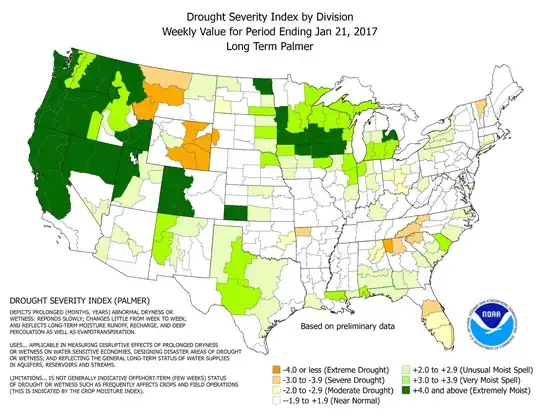Drought conditions in the United States are monitored by the US Geological Survey (USGS).
See the following link for current California hydrological drought conditions: https://waterwatch.usgs.gov/?m=dryw&r=ca
As of 08 January 2017, only a small area of California, roughly 5%, is in any degree of hydrological drought condition.
According to California government, as of 08 January 2017, on average, reservoirs are 100.63% of their normal level.
The largest reservoir, Shasta, is currently holding 120% of normal (average) amount.
Another factor to consider is the snowpack. Click here for daily snowpack data. As of 09 January 2017, state wide, the snowpack is 126% of normal for this date of the year.
Update 26 January 2017:
On the basis of reservoir levels, soil moisture, stream/river flow, and snowpack, the drought it over, but groundwater levels are still very low in some areas. So on a groundwater basis, which is very important to well water users, there is still a long term drought.
Snowpack is 189% of normal.
Reservoirs are 113% of normal.
Soil moisture is at or above normal in the entire state.
Stream and river flow is at or above normal across the state.

(Figure source)
However, the National Drought Mitigation Center states:
According to the San Joaquin precipitation index (an average across that region), January was the wettest ever observed in 112 years of record, and 4- to 5-year precipitation totals climbed dramatically from approximately the 2 percentile level as of early January to around the 20th percentile through this week. Statewide average snowpack (snow water equivalent) is almost twice normal for late January, and somewhat more than twice normal in the southern Sierra Nevada. Amounts actually exceed those typically recorded April 1 (snowpack climatological maximum). Given these dramatically wet indicators, widespread 1-category improvements were again instituted this week, wiping D4 from the state and restricting D3 to part of southwestern California. It should be noted, however, that to date groundwater levels have not responded as one might expect, and remain critically low. In most of the central foothills on the east side of the San Joaquin Valley, plus a number of other communities and cities across the nearby mountains and valleys, water supply is dependent on groundwater. Thus potable water is still being trucked in to serve residents with dry wells in areas such as Tuolumne County, and the deepest wells may not respond to the recent inundation for many more months.
